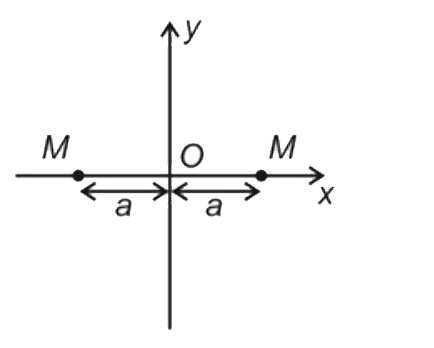There are two fixed heavy masses of magnitude M of high density at a distance 2d apart. On the axis, a small mass m moves in a circle of radius R in the y−z plane between the heavy masses. Find the velocity of the small particle.
To find the velocity of the small mass m moving in a circle of radius R between two fixed heavy masses M separated by a distance 2d, we can follow these steps:
Step 1: Analyze the Forces Acting on the Small Mass
The small mass m experiences gravitational forces due to both heavy masses M. The net gravitational force will act downwards due to symmetry, as the horizontal components of the forces from both masses will cancel each other out.
Step 2: Calculate the Gravitational Force
The gravitational force F exerted by one mass M on the small mass m can be expressed using Newton's law of gravitation:
F=GMmr2
where r is the distance from the mass M to the small mass m.
Step 3: Determine the Distance r
Since the small mass m is located at a distance d from the midpoint between the two masses, the distance r from each mass M to the small mass m is given by:
r=√d2+R2
where R is the radius of the circular motion.
Step 4: Calculate the Total Gravitational Force
The total gravitational force acting on mass m due to both masses M is:
Ftotal=2Fcos(θ)
where θ is the angle between the line connecting the mass m and the mass M and the vertical axis. From the geometry of the problem, we find:
cos(θ)=R√d2+R2
Thus, the total force becomes:
Ftotal=2⋅GMmr2⋅R√d2+R2
Step 5: Set the Gravitational Force Equal to the Centripetal Force
The gravitational force provides the necessary centripetal force for the circular motion of mass m:
Ftotal=mv2R
Equating the two forces gives:
2⋅GMm(d2+R2)⋅R√d2+R2=mv2R
Step 6: Solve for Velocity v
We can simplify this equation to find v:
2GMR=v2⋅(d2+R2)3/2R
Rearranging gives:
v2=2GMR2(d2+R2)3/2
Taking the square root, we find the velocity:
v=√2GMR2(d2+R2)3/2
Final Answer
The velocity of the small mass m moving in a circle of radius R is:
v=√2GMR2(d2+R2)3/2
The small mass m experiences gravitational forces due to both heavy masses M. The net gravitational force will act downwards due to symmetry, as the horizontal components of the forces from both masses will cancel each other out.
The gravitational force F exerted by one mass M on the small mass m can be expressed using Newton's law of gravitation:
F=GMmr2
where r is the distance from the mass M to the small mass m.
Since the small mass m is located at a distance d from the midpoint between the two masses, the distance r from each mass M to the small mass m is given by:
r=√d2+R2
where R is the radius of the circular motion.
The total gravitational force acting on mass m due to both masses M is:
Ftotal=2Fcos(θ)
where θ is the angle between the line connecting the mass m and the mass M and the vertical axis. From the geometry of the problem, we find:
cos(θ)=R√d2+R2
Thus, the total force becomes:
Ftotal=2⋅GMmr2⋅R√d2+R2
The gravitational force provides the necessary centripetal force for the circular motion of mass m:
Ftotal=mv2R
Equating the two forces gives:
2⋅GMm(d2+R2)⋅R√d2+R2=mv2R
We can simplify this equation to find v:
2GMR=v2⋅(d2+R2)3/2R
Rearranging gives:
v2=2GMR2(d2+R2)3/2
Taking the square root, we find the velocity:
v=√2GMR2(d2+R2)3/2
The velocity of the small mass m moving in a circle of radius R is:
v=√2GMR2(d2+R2)3/2
Topper's Solved these Questions
- GRAVITATIONBOOK - FIITJEECHAPTER - GRAVITATIONEXERCISE - Solved problem (Objective)
15 Videos
- GRAVITATIONBOOK - FIITJEECHAPTER - GRAVITATIONEXERCISE - Comprehension
13 Videos
- GRAVITATIONBOOK - FIITJEECHAPTER - GRAVITATIONEXERCISE - Numerical based Question
2 Videos
- GMP ASSESMENTBOOK - FIITJEECHAPTER - GMP ASSESMENTEXERCISE - Numerical Based
61 Videos
- HEAT AND TEMPERATUREBOOK - FIITJEECHAPTER - HEAT AND TEMPERATUREEXERCISE - NUMERICAL BASES QUESTIONS
1 Videos
Similar Questions
Two particles each of equal mass (m) move along a circle of radius (r) under the action of their mutual dravitational. Find the speed of each particle.

View Solution_S01_003_Q01.png)
Two particles of equal mass (m) each move in a circle of radius (r) under the action of their mutual gravitational attraction find the speed of each particle.
View Solution
Knowledge Check
If r represents the radius of the orbit of a satellite of mass m moving around a planet of mass M , the velocity of the satellite is given by
Av2=gMRBv2=GMmRCv=GMrDv2=GMrCentripetal acceleration of a particle of mass m moving in a circle of radius r is 4/r2. What is the angular momentum of the particle ?
A4 m/rB4m/√rC2m√rD2 m/rTwo point masses M are kept fixed on the x-axis at a distance a from the origin, another point mass m is moving in a circular path of radius R (in y - z plane) under the influence of gravitational force of attraction, then speed of m will be (Assume no forces are acting on m other than the gravitational forces by two M)
 A ⎷2GMR2(R2+a2)32B ⎷GMR2(R2+a2)32C ⎷3GMR2(R2+a2)32D ⎷5GMR2(R2+a2)32
A ⎷2GMR2(R2+a2)32B ⎷GMR2(R2+a2)32C ⎷3GMR2(R2+a2)32D ⎷5GMR2(R2+a2)32
Two particles of equal mass (m) move in a circle of radius (r ) under the action of their mutual gravitational attraction. Find the speed of each particle.
View SolutionTwo particles of equal mass m0 are moving round a circle of radius r due to their mutual gravitational interaction. Find the time period of each particle.
View SolutionHow much work is done in circulating a small object of mass m around a sphere of mass m in a circle of radius R.
View SolutionTwo particles of mass M and m are moving in a circle of radii R and r. if their time period are the same, what will be the ratio of their linear velocities?
View SolutionA particle of mass m is ocated at a distance r from the centre of shell of mass M and radius R. The force between the shell and mass F(r). The plot of F(r) ve r is :
View Solution
